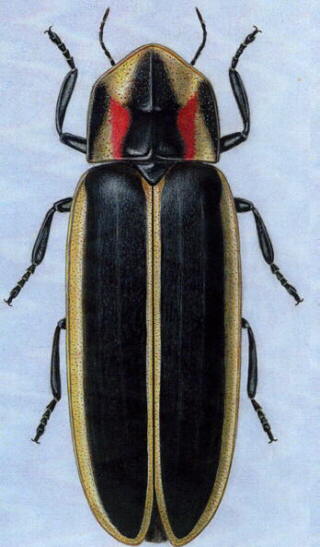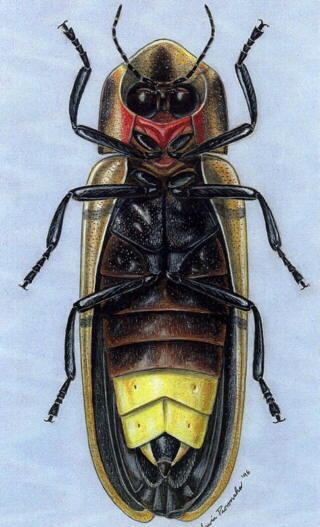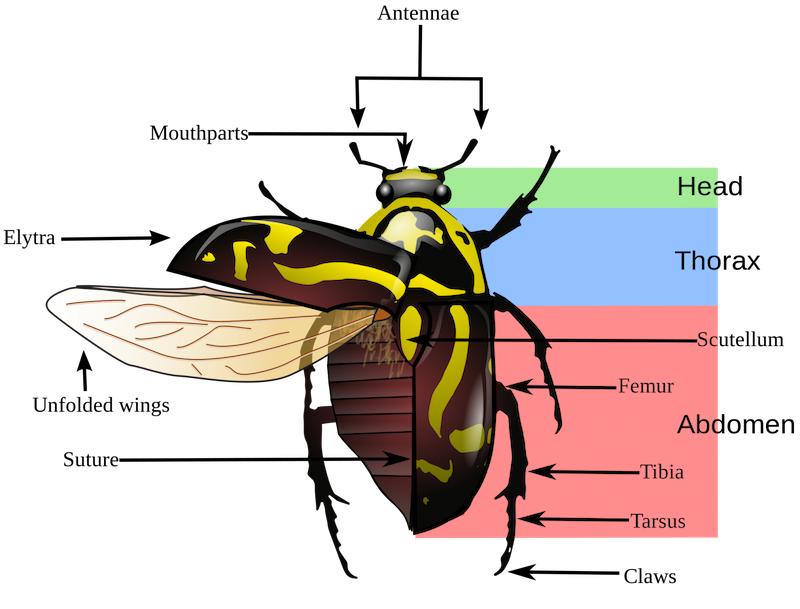
Illustration by WonderLab staff.
The Angled Candle Firefly, also known as Say’s Firefly for noted Hoosier entomologist Thomas Say, became the Indiana state insect in 2018. Although called a fire “fly” or lightning bug, like all fireflies, it is neither truly a fly nor a “bug.” (Technically a “bug” is a specific insect in the group Hemiptera with piercing mouthparts—but that’s another story for another day). Its scientific name is Pyractomena angulata and like all fireflies, it’s actually part of the beetle family.
You can spot the Angled Candle Firefly from early May through mid-July in Indiana. They are most frequently found in the wetlands and surrounding wooded areas.
Anatomy
All insects are distinguishable by certain characteristics. They have a head which contains sense organs, a thorax from which six legs extend, and an abdomen.
Antennae – “Feely Sensors”
The sense organs on insect heads include the eyes, mouthparts, and antennae. The antennae allow insects to respond to their environment through both tactile (touch) and olfactory (smell) receptors.
Antennae in beetles contain 11 different segments. The first is called the scape, where the antennae connects to the head in a socket. The second segment, called the pedicel, contains muscles that enable greater range of control over the antenna as a whole. The remaining nine segments together are called the flagellum.
Fireflies have filiform antennae, meaning each segment is approximately equal in size.
Leg – “Grubby Grabbers”
Fireflies in the Pyractomena genus have six legs. Their legs tend to be about 2-4mm in length which is generally shorter than the legs of other beetles. Beetle morphology includes leg sections: femur, tibia, tarsus, and a last segment containing a claw. Beetles walk in a “tripod” fashion; a foreleg and hind leg on one side touch the ground at the same time as the middle leg on its other side.
Wings – “Flight Flappers”
Like all beetles, fireflies have two sets of wings. The sixteen firefly species within the Pyractomena genus have top wings called elytra, which conceal hind wings. The elytra are tougher and shorter than the hind wings. They protect the insect when at rest, and provide balance during flight. The hind wings are the actual flying mechanism of the beetle and unfold when the elytra are lifted.
“Glowy Butt”
Finally, the anatomy for which fireflies are named: their glowy butts. Yes, the Angled Candle Firefly has a butt that glows. You knew that already. But how exactly do they do it – and why?
Although both male and female fireflies produce light, the organs that produce light differ between sexes. In male Pyractomena, the “glowy butt” is a light organism that occupies two abdominal segments. In females, glowing occurs through only four transparent dots.
The Angled Candle Firefly glows a little differently than other fireflies (there are more than 150 different kinds in North America alone!). If you see a firefly that glows and flickers like a campfire, that’s probably an Angled Candle Firefly. Their flash is amber and pulses rapidly about 8 to 12 times per second. Flashes happen every two to four-seconds.
Conservation
Firefly populations are dwindling worldwide. Light pollution, habitat loss, and pesticide use are the most serious threats to firefly populations. Some simple ways to help from your own home are by turning off exterior lights at night, avoiding pesticides, using natural fertilizers, and letting your friends know that they can help too!
Further reading: Want to try catching fireflies? Here’s a guide to do it safely!

Sources:
- Hadley D., (2020, January 2). Habits and Traits of True Bugs: Insects in the Order Hemiptera. ThoughtCo. Retrieved May 17, 2022, from https://www.thoughtco.com/true-bugs-order-hemiptera-1968634.
- (N.d.). Indiana’s Official State Insect. Indiana Department of Natural Resources. Retrieved May 17, 2022, from https://www.in.gov/dnr/entomology/resources-and-links/says-firefly/.
- (N.d.). Animals Reference: Fireflies. National Geographic. Retrieved May 17, 2022, from https://www.nationalgeographic.com/animals/invertebrates/facts/fireflies#:~:text=Fireflies%20have%20dedicated%20light%20organs,are%20unique%20to%20each%20species.
- Tibbets, Barbara. (2013, May/June). Fireflies (Lampyridae spp.), Outdoor Indiana. Retrieved May 17, 2022, from https://www.in.gov/dnr/entomology/files/com-oi-2013-firefly.pdf.
- Chow, A., Huval, F., Carrollton, C., & Reagan, G. (n.d.). Pyractomena spp., Spring Fireflies (Coleoptra: Lampyridae). LSU Ag Center. Retrieved May 17, 2022, from https://www.lsuagcenter.com/profiles/bneely/articles/page1590080943471.
- Buschman, L. (2016, March). Field Guide to Western North American Fireflies. Retrieved May 18, 2022 from https://static1.squarespace.com/static/59028899b3db2bade49af818/t/59b82118b078699228a63438/1505239322706/WesternFireflies+March+2016a.pdf.
- Kotz, S., (2017, April 25). The Parts of a Firefly Bug. Sciencing. Retrieved May 18, 2022, from https://sciencing.com/parts-firefly-bug-8555263.html.
- (N.d.) Antennae. NC State Agriculture and Life Sciences. Retrieved May 18, 2022, from https://genent.cals.ncsu.edu/bug-bytes/head/antennae/.
- (N.d.) Basic Insect Morphology. Nebraska Science Literacy and Outreach. Retrieved May 18, 2022, from https://entomology.unl.edu/scilit/basic-insect-morphology.
- (N.d.) Insect antennae. Amateur Entomologists’ Society. Retrieved May 18, 2022, from https://www.amentsoc.org/insects/fact-files/antennae.html#:~:text=The%20basic%20form%20of%20antenna,Lice%2C%20Scorpion%20Flies%20and%20Beetles.
- Benisch, C., (2007). Beetle morphology. Kerbtier.De Beetle Fauna of Germany. Retrieved May 18, 2022, from https://www.kerbtier.de/Pages/Themenseiten/enKoerperbau.html.
- (N.d.) How to help. Firefly conservation and research. https://www.firefly.org/how-you-can-help.html
- (2020, February 7). Lightning Bugs: At Risk of Extinction. PBS. Retrieved May 18, 2022, from https://www.pbs.org/wnet/nature/blog/lightning-bugs-at-risk-of-extinction/.
Image Sources:
- Anatomy Illustrations Provonshoa, Arwin. (N.d.). Retrieved May 18, 2022, from https://faculty.evansville.edu/ck6/bstud/firefly.html.
- (N.d.) Basic Insect Morphology. Retrieved May 18, 2022, from https://entomology.unl.edu/scilit/basic-insect-morphology.
- (N.d.) The structure of an insect antenna. Science Learn. Retrieved May 18, 2022, from https://www.sciencelearn.org.nz/resources/2756-insect-antennae.





Leave A Comment